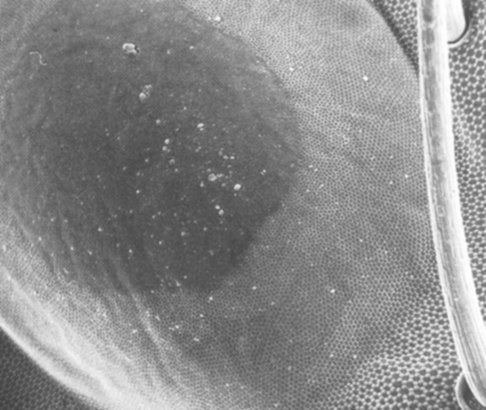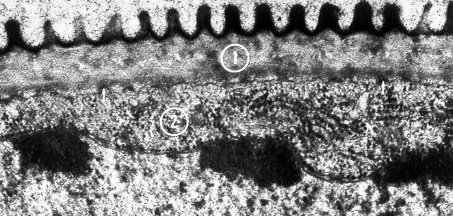http://www.collembola.org/publicat/integum/corneula.htm
Last updated on
2006.12.23
by Frans Janssens
Luc De Bruyn,
Department of Biology, University of Antwerp (RUCA), Antwerp, B-2020, Belgium
Jean-Auguste Barra,
Laboratoire de Zoologie, Université Louis Pasteur, Strasbourg, 67000, France
Frans Janssens,
Department of Biology, University of Antwerp, Antwerp, B-2020, Belgium
This page is under construction.
Barra, 1971:322-353 describes four different types of corneular
ultrastructure:
- corneula with a surface ultrastructure identical to the epicutilar
ultrastructure of the surrounding integument;
- corneula with a smooth surface;
- corneula with parallel ridges;
- corneula with nipples.
Corneula with microtubercular ultrastructure
Fig.1. Corneula with microtubercular ultrastructure of
Tomocerus problematicus
Barra, 1971.
 |
The corneula has a surface ultrastructure identical to the epicutilar
ultrastructure of the surrounding integument
(Fig.1 after Barra, 1971:Fig.1.A; x 6000).
The size of the microtubercular tesselation on the corneula is smaller
than that of the integument.
This type of corneula is found with Lepidocyrtus curvicollis,
Pseudosinella duodecimoculata, Tomocerus minor and
Tomocerus problematicus (Barra, 1971:327).
Corneula with smooth surface
Fig.2. Corneula with smooth surface of
Hypogastrura purpurescens
Barra, 1971.
 |
The corneula has a smooth surface and lacks a microtubercular ultrastructure
(Fig.2 after Barra, 1971:Fig.1.B; x 6000).
This type of corneula is found with species of the genus Hypogastrura,
more in particular with Hypogastrura tullbergi and
Hypogastrura purpurescens (Barra, 1971:327).
In Pseudachorutini, an intermediate arrangement is found:
the microtubercular tesselation is present only at a basal ocellar border
(Barra, 1971:Fig.2.A). This intermediate arrangement is also found
with Neanura muscorum (Barra, 1971:329).
In Isotoma aff. saltans, the hexagonal tesselation is
also completely lacking on the surface of the ocelli
(Eisenbeis & Wichard, 1985:227(Tafel 103 fig.e)).
Corneula with parallel ridges
Fig.3a. Epicuticular ultrastructure of ocellus of
Pogonognathellus flavescens
Eisenbeis & Wichard, 1985.
 |
Fig.3b. Differentiation in the epicuticular ultrastructure of the corneula of the ocellus of Pogonognathellus flavescens
Eisenbeis & Wichard, 1985.
 |
In Pogonognathellus flavescens,
a differentiation of the surface structure of the ocelli is observed (Fig.o,p):
at the base of the ocellus the typical microtubercular pattern is found
but it does not occur at the centre of the corneula
(Eisenbeis & Wichard, 1985:205(Tafel 92 fig.b & fig.c)).
Note also the size gradient of the hexagons on the ocellus compared to
those on the integument of the head.
Fig.3c. Corneula with parallel ridges of
Pogonognathellus longicornis
Barra, 1971.
 |
Fresnell effects? To be completed.
Corneula with nipples
Fig.4. Corneula with nipples of
Dicyrtoma atra
Barra, 1971.
 |
To be completed.





